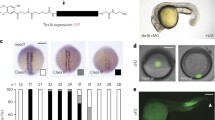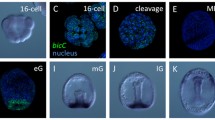Abstract
In the sea urchin embryo, micromeres have two distinct functions: they differentiate cell autonomously into the skeletogenic mesenchyme cells and act as an organizing center that induces endomesoderm formation. We demonstrated that micro1 controls micromere specification as a transcriptional repressor. Because micro1 is a multicopy gene with at least six polymorphic loci, it has been difficult to consistently block micro1 function by morpholino-mediated knockdown. Here, to block micro1 function, we used an active activator of micro1 consisting of a fusion protein of the VP16 activation domain and the micro1 homeodomain. Embryos injected with mRNA encoding the fusion protein exhibited a phenotype similar to that of micromere-less embryos. To evaluate micro1 function in the micromere, we constructed chimeric embryos composed of animal cap mesomeres and a micromere quartet from embryos injected with the fusion protein mRNA. The chimeras developed into dauerblastulae with no vegetal structures, in which the micromere progeny constituted the blastula wall. We also analyzed the phenotype of chimeras composed of an animal cap and a mesomere expressing micro1. These chimeras developed into pluteus larvae, in which the mesomere descendants ingressed as primary mesenchyme cells and formed a complete set of skeletal rods. The hindgut and a part of the midgut were also generated from host mesomeres. However, the foregut and nonskeletogenic mesoderm were not formed in the larvae. From these observations, we conclude that micro1 is necessary and sufficient for both micromere differentiation and mid/hindgut-inducing activity, and we also suggest that micro1 may not fulfill all micromere functions.





Similar content being viewed by others
References
Akasaka K, Ueda T, Higashinakagawa T, Yamada K, Shimada H (1990) Spatial pattern of arylsulfatase mRNA expression in sea urchin embryo. Dev Growth Differ 32:9–13
Akasaka K, Uemoto H, Wilt F, Mitsunaga-Nakatsubo K, Shimada H (1997) Oral–aboral ectoderm differentiation of the sea urchin embryos is disrupted in response to calcium ionophore. Dev Growth Differ 39:373–379
Amemiya S (1996) Complete regulation of development throughout metamorphosis of sea urchin embryos devoid of macromeres. Dev Growth Differ 38:465–476
Angerer LM, Angerer RC (2003) Patterning the sea urchin embryos: gene regulatory networks, signaling pathways, and cellular interactions. Curr Top Dev Biol 53:159–198
Angerer LM, Oleksyn DW, Levine AM, Li X, Klein WH, Angerer RC (2001) Sea urchin goosecoid function links fate specification along the animal–vegetal and oral–aboral embryonic axes. Development 128:4393–4404
Arenas-Mena C, Cameron RA, Davidson EH (2000) Spatial expression of Hox cluster genes in the ontogeny of a sea urchin. Development 127:4631–4643
Di Bernardo M, Russo R, Oliveri P, Melfi R, Spinelli G (1995) Homeobox-containing gene transiently expressed in a spatially restricted pattern in the early sea urchin embryo. Proc Natl Acad Sci U S A 92:8180–8184
Emily-Fenouil F, Ghiglione C, Lhomond G, Lepage T, Gache C (1998) GSK3beta/shaggy mediates patterning along the animal–vegetal axis of the sea urchin embryo. Development 125:2489–2498
Ettensohn CA, Illies MR, Oliveri P, De Jong DL (2003) Alx1, a member of the Cart1/Alx3/Alx4 subfamily of paired-class homeodomain proteins, is an essential component of the gene network controlling skeletogenic fate specification in the sea urchin embryo. Development 130:2917–2928
Fuchikami T, Mitsunaga-Nakatsubo K, Amemiya S, Hosomi T, Watanabe T, Kurokawa D, Karaoka M, Harada Y, Satoh N, Kusunoki S, Takata K, Shimotori T, Yamamoto T, Sakamoto N, Shimada H, Akasaka K (2002) T-brain homologue (HpTb) is involved in the archenteron induction signals of micromere descendant cells in the sea urchin embryo. Development 129:5205–5216
Gan L, Wessel GM, Klein WH (1990) Regulatory elements from the Spec genes of Strongylocentrotus purpuratus yield different spatial patterns with a lacZ reporter gene. Dev Biol 142:346–359
Hörstadius S (1973) Experimental embryology of echinoderms. Clarendon, Oxford
Howard EW, Newman LA, Oleksyn DW, Angerer RC, Angerer LM (2001) SpKrl: a direct target of beta-catenin regulation required for endoderm differentiation in sea urchin embryos. Development 128:365–375
Katoh-Fukui Y, Noce T, Ueda T, Fujiwara Y, Hashimoto N, Tanaka S, Higashinakagawa T (1992) Isolation and characterization of cDNA encoding a spicule matrix protein in Hemicentrotus pulcherrimus micromeres. Int J Dev Biol 36:353–361
Kenny AP, Kozlowski DJ, Oleksyn DW, Angerer LM, Angerer RC (1999) SpSoxB1, a maternally encoded transcription factor asymmetrically distributed among early sea urchin blastomeres. Development 126:5473–5483
Kenny AP, Oleksyn DW, Newman LA, Angerer RC, Angerer LM (2003) Tight regulation of SoxB factors is required for patterning and morphogenesis in sea urchin embryos. Dev Biol 261:412–425
Kitamura K, Nishimura Y, Kubotera N, Higuchi Y, Yamaguchi M (2002) Transient activation of the micro1 homeobox gene family in the sea urchin (Hemicentrotus pulcherrimus) micromere. Dev Genes Evol 212:1–10
Kominami T (1998) Role of cell adhesion in the specification of pigment cell lineage in embryos of the sea urchin, Hemicentrotus pulcherrimus. Dev Growth Differ 40:609–618
Kurokawa D, Kitajima T, Mitsunaga-Nakatsubo K, Amemiya S, Shimada H, Akasaka K (1999) HpEts, an ets-related transcription factor implicated in primary mesenchyme cell differentiation in the sea urchin embryo. Mech Dev 80:41–52
Logan CY, Miller JR, Fercowicz MJ, McClay DR (1999) Nuclear β-catenin is required to specify vegetal cell fates in the sea urchin embryo. Development 126:345–357
Mailhos C, André S, Mollereau B, Goriely A, Hemmati-Brivanlou A, Desplan C (1998) Drosophila Goosecoid requires a conserved heptapeptide for repression of Paired-class homeoprotein activators. Development 125:937–947
McClay DR, Peterson RE, Range RC, Winter-Vann AM, Ferkowicz MJ (2000) A micromere induction signal is activated by β-catenin and acts through Notch to initiate specification of secondary mesenchyme cells in the sea urchin embryo. Development 127:5113–5122
Minokawa T, Amemiya S (1998) Mesodermal cell differentiation in echinoid embryos derived from the animal cap recombined with a quartet of micromeres. Zoolog Sci 15:541–545
Minokawa T, Rast JP, Arenas-Mena C, Franco CB, Davidson EH (2004) Expression patterns of four different regulatory genes that function during sea urchin development. Gene Expr Patterns 4:449–456
Nishimura Y, Sato T, Morita Y, Yamazaki A, Akasaka K, Yamaguchi M (2004) Structure, regulation, and function of micro1 in the sea urchin Hemicentrotus pulcherrimus. Dev Genes Evol 214:525–536
Okazaki K (1975a) Spicule formation by isolated micromeres of the sea urchin embryo. Am Zool 15:567–581
Okazaki K (1975b) Normal development to metamorphosis. In: Czihak G (ed) The sea urchin embryo. Springer, Berlin Heidelberg New York, pp 177–233
Oliveri P, Carric DM, Davidson EH (2002) A regulatory network that directs micromere specification in the sea urchin embryo. Dev Biol 246:209–228
Oliveri O, Davidson EH, McClay DR (2003) Activation of pmar1 controls specification of micromeres in the sea urchin embryo. Dev Biol 258:32–43
Ransick A, Davidson EH (1993) A complete second gut induced by transplanted micromeres in the sea urchin embryo. Science 259:1134–1138
Ransick A, Davidson EH (1995) Micromeres are required for normal vegetal plate specification in sea urchin embryos. Development 121:3215–3222
Sherwood DR, McClay DR (1997) Identification and localization of a sea urchin Notch homologue: insights into vegetal plate regionalization and Notch receptor regulation. Development 124:3363–3374
Sherwood DR, McClay DR (1999) LvNotch signaling mediates secondary mesenchyme specification in the sea urchin embryo. Development 126:1703–1713
Sherwood DR, McClay DR (2001) LvNotch signaling plays a dual role in regulating the position of the ectoderm–endoderm boundary in the sea urchin embryo. Development 128:2221–2232
Smith SJ, Jaynes JB (1996) A conserved region of engrailed, shared among all en-, gsc-, Nk1-, Nk2- and msh-class homeoproteins, mediates active transcriptional repression in vivo. Development 122:3141–3150
Sweet HC, Hodor PG, Ettensohn CA (1999) The role of micromere signaling in Notch activation and mesoderm specification during sea urchin embryogenesis. Development 126:5155–5265
Sweet HC, Gehring M, Ettensohn CA (2002) LvDelta is a mesoderm-inducing signal in the sea urchin embryo and can endow blastomeres with organizer-like properties. Development 129:1945–1955
Takacs CM, Amore G, Oliveri P, Poustka AJ, Wang D, Burke RD, Peterson KJ (2004) Expression of an NK2 homeodomain gene in the apical ectoderm defines a new territory in the early sea urchin embryo. Dev Biol 269:152–164
Vonica A, Weng W, Gunbiner BM, Venuti JM (2000) TCF is the nuclear effector of the beta-catenin signal that patterns the sea urchin animal–vegetal axis. Dev Biol 217:230–243
Whittaker JR, Meedel TH (1989) Two histospecific enzyme expressions in the same cleavage-arrested one-celled ascidian embryos. J Exp Zool 250:168–175
Wikramanayake AH, Huang L, Klein WH (1998) β-Catenin is essential for patterning the maternally specified animal–vegetal axis in the sea urchin embryo. Proc Natl Acad Sci U S A 95:9343–9348
Wikramanayake AH, Peterson R, Chen J, Huang L, Bince JM, McClay DR, Klein WH (2004) Nuclear β-catenin-dependent Wnt8 signaling in vegetal cells of the early sea urchin embryo regulates gastrulation and differentiation of endoderm and mesoderm cell lineages. Genesis 39:194–205
Yamaguchi M, Kinoshita T, Ohba Y (1994) Fractionation of micromeres, mesomeres, and macromeres of 16-cell stage sea urchin embryos by elutriation. Dev Growth Differ 36:381–387
Yoshikawa S (1997) Oral/aboral ectoderm differentiation of the sea urchin embryo depends on a planar or secretory signal from the vegetal half. Dev Growth Differ 39:319–327
Acknowledgements
We thank Hiroshi Kubota for the Hpoe monoclonal antibody, Hideki Katow for the P4 monoclonal antibody, and Masato Kiyomoto for supplying the mature adult H. pulcherrimus.
Author information
Authors and Affiliations
Corresponding author
Additional information
Communicated by N. Satoh.
A. Yamazaki and R. Kawabata contributed equally to this study
Rights and permissions
About this article
Cite this article
Yamazaki, A., Kawabata, R., Shiomi, K. et al. The micro1 gene is necessary and sufficient for micromere differentiation and mid/hindgut-inducing activity in the sea urchin embryo. Dev Genes Evol 215, 450–459 (2005). https://doi.org/10.1007/s00427-005-0006-y
Received:
Accepted:
Published:
Issue Date:
DOI: https://doi.org/10.1007/s00427-005-0006-y




